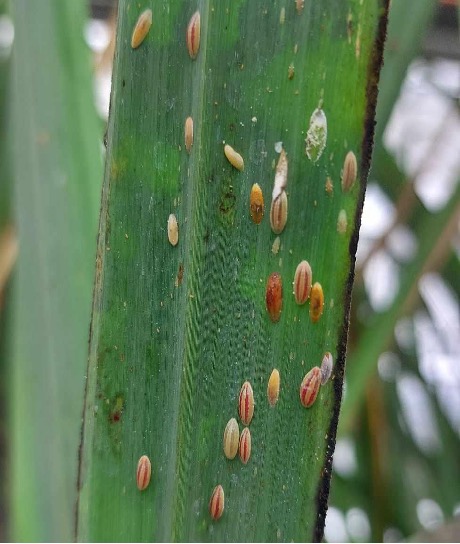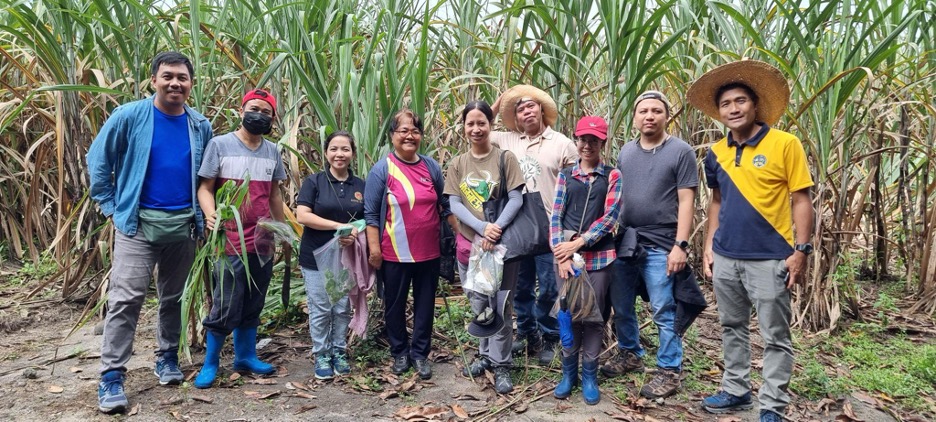NCPC-Quick Response Team and SRA-LAREC staff visit a sugarcane field at Brgy. Salu, Porac, Pampanga. (Photo by NCPC)
The National Crop Protection Center – Quick Response Team (NCPC – QRT) visited the provinces of Pampanga and Batangas last September 5 and 13 to monitor a newly reported sugarcane insect pest observed by the Sugar Regulatory Administration – Luzon Agricultural Research and Extension Center (SRA-LAREC). Together with the SRA-LAREC staff, the team conducted ocular inspection and sample collection at the SRA-LAREC station and on sugarcane fields in Porac, Pampanga and Calaca and Balayan in Batangas.
The NCPC conducted molecular and morphological characterization to identify the unknown insect pest. Molecular characterization showed that 99.71% of its nucleotide identity matches Pulvinaria saccharia. However, based on previous morphological analysis reports, P. saccharia is a junior synonym of Pulvinaria tenuivalvata, which is more accurate to use. Pulvinaria tenuivalvata is commonly called red-striped soft scale.
According to SRA-LAREC, the pest was first observed in the province of Pampanga, particularly in Bacolor, in June 2022 and then, at SRA-LAREC station in February 2023.The first reported incidence in Balayan, Batangas, was in August 2023.

The red-striped soft scale is usually found on the lower surfaces at the middle leaf portion of sugarcane. It sucks the leaf which causes its yellowing. During the field visit at SRA-LAREC and Porac, Pampanga, the NCPC-QRT observed an endoparasitic parasitoid that killed the adults of the red-striped soft scale. The endoparasitic parasitoid effectively controlled the red-striped soft scale in those areas, with a 30% parasitism rate in SRA-LAREC and 67% in Porac. On the other hand, white, pink, and black fungal growths were observed to cover the soft scale insect, possibly causing the death of the pest. These fungal species covering the insect will be isolated, identified, and tested as potential entomopathogenic fungi.
Red-striped soft scale insect in sugarcane (Photo by RLMiras)
Other insect pests observed in sugarcane were aphids and mealybugs. The disease included sooty mold, red rot, spots, and leaf scorching with blighting and browning of the leaf blade. Among the weeds associated with sugarcane, three are possible alternate hosts of the red-striped soft scale.
The NCPC conducted a visual damage assessment and brief aerial survey in two sugarcane fields at Brgy. Pooc, Balayan, Batangas. Based on the assessment, one of the fields had moderate damage, while the other was heavily infested at a range of 20-40%.
A new sighting of a red-striped soft scale in Brgy. Punta and Brgy. Burol, Calamba City, Laguna was observed in September. Parasitism was also evident but not quantified in the sugarcane areas of Calamba.
The NCPC proposes a rapid assessment of infestation of the pest in sugarcane-producing provinces across Luzon to gauge the extent of field damage, population dynamics, and the presence of parasitoids in the identified areas. The center also encourages the stakeholders in the regions in Visayas and Mindanao with substantial sugarcane production to be vigilant in monitoring potential incursions of this pest. (First published in the Aggie Green & Gold newsletter, September 2023 issue)








